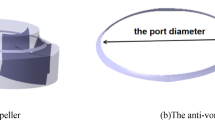Abstract
Two examples of the use of vortex control to reduce noise and enhance the stable operating range of a centrifugal compressor are presented in this paper. In the case of high-flow operation of a centrifugal compressor with a vaned diffuser, a discrete frequency noise induced by interaction between the impeller-discharge flow and the diffuser vane, which appears most notably in the power spectra of the radiated noise, can be reduced using a tapered diffuser vane (TDV) without affecting the performance of the compressor. Twin longitudinal vortices produced by leakage flow passing through the tapered portion of the diffuser vane induce secondary flow in the direction of the blade surface and prevent flow separation from the leading edge of the diffuser. The use of a TDV can effectively reduce both the discrete frequency noise generated by the interaction between the impeller-discharge flow and the diffuser surface and the broadband turbulent noise component. In the case of low-flow operation, a leading-edge vortex (LEV) that forms on the shroud side of the suction surface near the leading edge of the diffuser increases significantly in size and blocks flow in the diffuser passage. The formation of an LEV may adversely affect the performance of the compressor and may cause the diffuser to stall. Using a one-side tapered diffuser vane to suppress the evolution of an LEV, the stable operating range of the compressor can be increased by more than 12 percent, and the pressure-rise characteristics of the compressor can be improved. The results of a supplementary examination of the structure and unsteady behavior of LEVs, conducted by means of detailed numerical simulations, are also presented.
Similar content being viewed by others
Abbreviations
- B :
-
blade and vane height (m)
- D :
-
diameter(m)
- N :
-
compressor rotational speed(min−1)
- P T :
-
total pressure(Pa)
- Q :
-
volume flow rate(m3/s)
- V :
-
number of diffuser vanes
- Z :
-
number of impeller blades
- ϕ :
-
flow coefficient(= Q/π2D 22 B 2 N)
- ρ :
-
air density(kg/m3)
- ψ T :
-
total pressure rise coefficient(= 2P T /ρπ 2D 22 N 2)
- 1:
-
Impeller inlet
- 2:
-
impeller outlet
- 3:
-
diffuser leading-edge
- 4:
-
diffuser trailing-edge
- BPF:
-
blade passing frequency
- HDV:
-
hub-side tapered diffuser vane
- ITN:
-
interaction tone noise
- LEV:
-
leading-edge vortex
- ODV:
-
original wedge-type diffuser vane
- SDV:
-
shroud-side tapered diffuser vane
- TDV:
-
two-sided tapered diffuser vane
- VL:
-
vaneless diffuser
References
Denton, J. D., “Loss Mechanisms in Turbomachines”, Trans. of the ASME, J. of Turbomachinery, Vol.115, pp.621–656, (1993).
Yamada, K., Kikuta, H., Iwakiri, K., Furukawa, M. and Gunjishima, S., “An Explanation for Flow Features of Spike-Type Stall Inception in an Axial Compressor Rotor”, Trans. of the ASME, J. of Turbomachinery, Vol.135, No.2, 021023 (11), (2013).
Outa, E., Ohta, Y., Kato, D. and Chiba, K., “Two-dimensional Study on Evolution of Deep Rotating Stall under Uniform Inlet Conditions in an Axial Compressor Cascades”, Proc. of 14th ISABE, pp.1–11, Florence, Italy, (1999).
Mailach, R., Lehmann, I. and Vogeler, K., “Rotating Instabilities in an Axial Compressor Originating from the Fluctuating Blade Tip Vortex”, Trans. of the ASME, J. of Turbomachinery, Vol.123, pp.453–460, (2001).
März, J., Hah, C. and Neise, W., “An Experimental and Numerical Investigation into the Mechanism of Rotating Instability”, Trans. of the ASME, J. of Turbomachinery, Vol.124, pp.367–375, (2002).
Fukuda, Y., Takeyama, Y. and Ohta, Y., “Characteristics of Rotating Instability in a Centrifugal Blower with Shrouded Impeller”, Trans. of the JSME (in Japanese), Vol.80, No.809, DOI: 10.1299/transjsme. 2014fe000X, (2014).
Yoshinaga, Y., Gyobu, I., Mishima, H., Koseki, F. and Nishida, H., “Aerodynamic Performance of a Centrifugal Compressor with Vaned Diffusers”, Trans. of the ASME, J. of Fluids Engineering, Vol. 102, pp.486–493, (1980).
Ohta, Y., Goto, T. and Outa, E., “Effects of Tapered Diffuser Vane on the Flow Field and Noise of a Centrifugal Compressor”, J. of Thermal Science, Vol.16, No.4, pp.301–308, (2007).
Fujisawa, N., Hara, S., Ohta, Y. and Goto, T., “Unsteady Behavior of Leading Edge Vortex and Diffuser Stall Inception in a Centrifugal Compressor with Vaned Diffuser”, Proc. of ASME FEDSM, FEDSM2014-21242, pp.1–9, Chicago, USA, (2014).
Steger, J. L. and Warming, R. F., “Flux Vector Splitting of the Inviscid Gasdynamic Equations with Application to Finite-Difference Methods”, J. of Computational Physics, Vol.40, pp.263–293, (1981).
Leer, V. B., “Towards the Ultimate Conservative Difference Scheme, A Second-Order Sequel to Godunov’s Method”, J. of Computational Physics, Vol.32, pp.101–136, (1979).
Yoon, S. and Jameson, A., “Lower-Upper Symmetric-Gauss-Seidel Method for the Euler and Navier-Stokes Equations”, AIAA Journal, Vol.26, pp.1025–1026, (1998).
Spalart, P. R. and Allmaras, S. R., “A One-Equation Turbulence Model for Aerodynamic Flows” AIAA Paper 92–0439, (1992).
Strelets, M., “Detached Eddy Simulation of Massively Separated Flows”, AIAA Paper 2001-0879, 39th AIAA Aerospace Sciences Meeting and Exhibit, January 8–11, Reno, Nevada, USA, (2001).
Steger, J. L., “A Chimera Grid Schemes”, ASME FED, Vol.5, “Advances in Grid generation”, (1983).
Thompson, K. W., “Time Dependent Boundary Conditions for Hyperbolic Systems”, J. of Computational Physics, Vol.68, pp.1–24, (1987).
Tyler, J. M. and Sofrin, T. G., “Axial Flow Compressor Noise Studies, Society of Automotive Engineers Transactions, Vol.70, 99.309–322, (1962).
Jeong, J. and Hussain, F., “On the Identification of a Vortex”, J. of Fluid Mechanics, Vol.285, pp.69–94, (1995).
Ohta, Y., Goto, T. and Outa, E., “Unsteady Behavior and Control of Diffuser Leading-Edge Vortex in a Centrifugal Compressor”, Proc. of ASME Turbo Expo 2010, GT2010-22394, June 14–18, Glasgow, UK, (2010).
Author information
Authors and Affiliations
Rights and permissions
About this article
Cite this article
Ohta, Y., Fujisawa, N. Unsteady behavior and control of vortices in centrifugal compressor. J. Therm. Sci. 23, 401–411 (2014). https://doi.org/10.1007/s11630-014-0723-5
Received:
Published:
Issue Date:
DOI: https://doi.org/10.1007/s11630-014-0723-5



